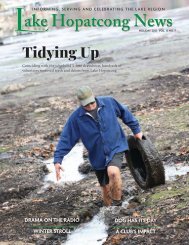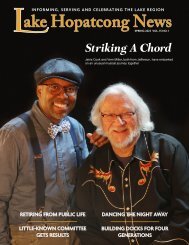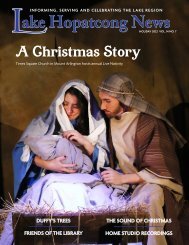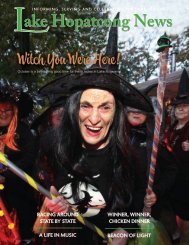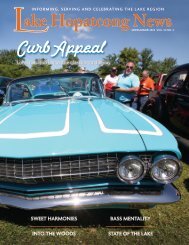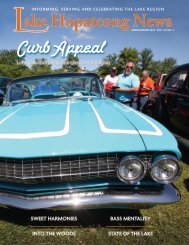You also want an ePaper? Increase the reach of your titles
YUMPU automatically turns print PDFs into web optimized ePapers that Google loves.
HISTORY<br />
A Beacon in the Styx<br />
by MARTY KANE<br />
Photos courtesy<br />
of the<br />
LAKE HOPATCONG<br />
HISTORICAL<br />
MUSEUM<br />
This spring I learned that, after a 21-year<br />
run, Mario Ferra sold Pavinci Italian Grill<br />
to three partners who already own two pubstyle<br />
restaurants in Manhattan. Renovations<br />
to the River Styx location are expected to be<br />
completed shortly and include a new deck and<br />
remodeled interior.<br />
The new establishment will be known as<br />
The Beacon and continues the evolution of<br />
this location, which has been home to several<br />
popular long-term businesses over many years.<br />
River Styx Cove was sparsely developed<br />
in 1906 when Martin Kjellman established a<br />
houseboat as a refreshment stand. The August<br />
11, 1906 edition of the Lake Hopatcong Breeze<br />
reported that “the house boat [sic] on the<br />
Styx is pictured on souvenir postcards. Martin<br />
Kjellman, the Captain, does his utmost toward<br />
keeping the Styx dwellers cool.”<br />
A 1908 advertisement bills the houseboat<br />
as “the most unique and popular place on the<br />
lake for all kinds of refreshments, such as ice<br />
cream, fancy biscuits, orangeade, soft drinks …<br />
Cigars, tobacco and souvenir postals for sale.”<br />
To convince boat owners that River Styx<br />
Cove was not too shallow to navigate, early<br />
ads for the houseboat noted “water deep<br />
enough for launches.” Kjellman’s idea proved<br />
successful, and his business grew.<br />
The June 29, 1912 edition of the Breeze<br />
reported that “the houseboat on the Styx is<br />
no more. It has changed into something better<br />
and more beautiful, as a butterfly comes forth<br />
from its chrysalis. It is now the Pagoda, which<br />
the dictionary informs us means a Hindu<br />
temple. The Pagoda in the Styx is indeed a<br />
temple of pleasure.”<br />
The article further noted that “the structure<br />
with its wide porches, white columns and<br />
unique roof makes a pretty picture and is well<br />
worth a visit in itself to say nothing of the dainty<br />
refreshments served there for a consideration<br />
by the busy hands of Mrs. Kjellman.”<br />
While the Breeze reporter may have been a<br />
bit confused about the architectural style of<br />
the River Styx pagoda, one can imagine how<br />
surprised visitors arriving for the 1912 season<br />
were to see this new structure. How odd it<br />
must have seemed to enjoy a refreshment<br />
in this Asian-inspired building while looking<br />
across River Styx at the imposing hotel Castle<br />
Edward, built to resemble a European castle.<br />
The early Pagoda offered useful items such<br />
as film and postcards, along with Schrafft’s<br />
chocolates and Viedt’s ice cream served on an<br />
open-air porch.<br />
The porch was enclosed, and an addition<br />
was built during the 1920s and 1930s to create<br />
a luncheonette and soda fountain. By 1940,<br />
the Pagoda added a swimming dock, housed<br />
the post office, offered bungalows for lease<br />
and became a popular spot to rent boats<br />
and canoes, while still maintaining the lunch<br />
counter and soda fountain.<br />
During this era, the Pagoda also housed<br />
Goody’s Bike Station, where visitors could rent<br />
bikes for 25 cents per hour or $1.50 per day.<br />
Following World War II, the Pagoda added gas<br />
pumps for boats and cars.<br />
The Kjellmans sold the Pagoda in the late<br />
1920s to the Osterblom family, who owned it<br />
for nearly 40 years, until they sold to Lennie<br />
Eisenstein in the mid-1960s.<br />
Envisioning the business as a full-service<br />
restaurant, Eisenstein built another addition,<br />
which he called the Lobster Shack. Len E’s<br />
Pagoda and Lobster Shack proved to be very<br />
popular. When the church next door became<br />
available, Eisenstein had even grander plans.<br />
The first church services in the Borough of<br />
Hopatcong were held during the<br />
late 19th and early 20th centuries<br />
by the Rev. T.A.K. Gessler at Tangle<br />
Wild, his property in Davis Cove. After the<br />
Hopatcong School (later Hudson Maxim<br />
School) was built in River Styx in 1908, church<br />
services were conducted in the one-room<br />
schoolhouse. Locals noted that the borough<br />
had a jail but no church.<br />
On July 2, 1911, the cornerstone for the West<br />
Side Church, the borough’s first church, was laid.<br />
Gessler preached at the nondenominational<br />
church until his death in 1925.<br />
In 1949, following a vote of the congregation,<br />
the church became the West Side United<br />
Methodist Church. After a 1968 fire gutted the<br />
inside of the church, the congregation decided<br />
more space was needed. A new church was<br />
built across River Styx Bridge on Maxim Drive,<br />
opening in 1971.<br />
The old West Side Church structure seemed<br />
headed for the wrecking ball, but Lennie<br />
Eisenstein had another idea.<br />
Having doubled the size of the Pagoda,<br />
Eisenstein bought the church building and<br />
connected it to his existing establishment,<br />
creating one large restaurant. Though unique,<br />
the expansion proved to be a step too far.<br />
Overextended financially, the restaurant was<br />
forced to close.<br />
The business reopened under new owners<br />
as the Jolly Buccaneer in 1975 and, after being<br />
sold again, became the Lighthouse in 1978. The<br />
Lighthouse operated as a dinner theatre for a<br />
year before latching onto the disco craze of<br />
the late 1970s.<br />
With its large dance floor and numerous bars<br />
on multiple levels, The Lighthouse became<br />
one of the most popular clubs in New Jersey,<br />
drawing customers from a wide area. The<br />
steeple of the church served as the Rock<br />
Room, a unique venue for live bands.<br />
Following the Lighthouse’s closure in the mid-<br />
1980s, several other restaurants experienced<br />
various degrees of success at the location.<br />
During this period the unique remaining<br />
portion of the old pagoda roof was covered.<br />
(It remains under the existing roof, should a<br />
future owner wish to revisit the establishment’s<br />
original theme.)<br />
With the turn of the century, the property<br />
was split into three different businesses and<br />
given fresh life by new owners led by Scott<br />
Barber.<br />
Johnny’s Marina, long run by the Salamone<br />
family, offers boat slips, sales, repairs and a wide<br />
variety of boating and fishing<br />
supplies. In the former church<br />
structure, Barber and his team<br />
established the Barber Shop,<br />
a state-of-the-art recording<br />
studio. And in the restaurant<br />
Far left: The Pagoda, circa 1912,<br />
which replaced a houseboat,<br />
circa 1908, that served<br />
refreshments (immediate left).<br />
34<br />
LAKE HOPATCONG NEWS <strong>Memorial</strong> <strong>Day</strong> <strong>2023</strong>





